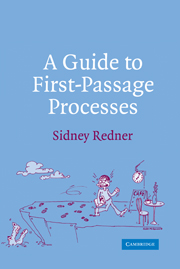Book contents
- Frontmatter
- Contents
- Preface
- Errata
- 1 First-Passage Fundamentals
- 2 First Passage in an Interval
- 3 Semi-Infinite System
- 4 Illustrations of First Passage in Simple Geometries
- 5 Fractal and Nonfractal Networks
- 6 Systems with Spherical Symmetry
- 7 Wedge Domains
- 8 Applications to Simple Reactions
- References
- Index
8 - Applications to Simple Reactions
Published online by Cambridge University Press: 05 August 2012
- Frontmatter
- Contents
- Preface
- Errata
- 1 First-Passage Fundamentals
- 2 First Passage in an Interval
- 3 Semi-Infinite System
- 4 Illustrations of First Passage in Simple Geometries
- 5 Fractal and Nonfractal Networks
- 6 Systems with Spherical Symmetry
- 7 Wedge Domains
- 8 Applications to Simple Reactions
- References
- Index
Summary
Reactions as First-Passage Processes
In this last chapter, we investigate simple particle reactions whose kinetics can be understood in terms of first-passage phenomena. These are typically diffusion-controlled reactions, in which diffusing particles are immediately converted to a product whenever a pair of them meets. The term diffusion controlled refers to the fact that the reaction itself is fast and the overall kinetics is controlled by the transport mechanism that brings reactive pairs together. Because the reaction occurs when particles first meet, first-passage processes provide a useful perspective for understanding the kinetics.
We begin by treating the trapping reaction, in which diffusing particles are permanently captured whenever they meet immobile trap particles. For a finite density of randomly distributed static traps, the asymptotic survival probability S(t) is controlled by rare, but large trap-free regions.We obtain this survival probability exactly in one dimension and by a Lifshitz tail argument in higher dimensions that focuses on these rare configurations [Lifshitz, Gredeskul, & Pastur (1988)]. At long times, we find that S(t) exp(−Atd/d+2), where A is a constant and d is the spatial dimension. This peculiar form for the survival probability was the focus of considerable theoretical effort that ultimately elucidated the role of extreme fluctuations on asymptotic behavior [see, e.g., Rosenstock (1969), Balagurov & Vaks (1974), Donsker & Varadhan (1975, 1979), Bixon & Zwanzig (1981), Grassberger & Procaccia (1982a), Kayser & Hubbard (1983), Havlin et al. (1984), and Agmon & Glasser (1986)].
We next discuss diffusion-controlled reactions in one dimension.
Information
- Type
- Chapter
- Information
- A Guide to First-Passage Processes , pp. 252 - 294Publisher: Cambridge University PressPrint publication year: 2001
Accessibility standard: Unknown
Why this information is here
This section outlines the accessibility features of this content - including support for screen readers, full keyboard navigation and high-contrast display options. This may not be relevant for you.Accessibility Information
- 1
- Cited by
